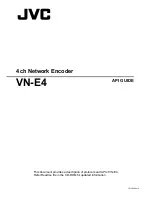
— 106 —
6F3A4768
(1) When positive current is flowing into the motor:
When flowing the positive current, two states a) and b) are controlled by the on/off control of the IGBTU and
IGBTX to control the voltage output from the U-phase.
a) IGBTU is on. (IGBTX is off.)
IGBTU is on and IGBTX is off.
At this time, the IGBT1 outputs the positive potential (P) of the DC power supply. After that, the current
flows through a loop so that it flows into the motor and returns to virtual 0 V of the converter through the
virtual neutral point. (Actually, even though the neutral point is not connected, it seems that the current
flows through equivalent neutral point since the V and W phases are provided.)
b) IGBTX is on. (IGBTU is off.)
IGBTX is on and IGBTU is off.
When positive current is applied, the current does not flow into the IGBTX even though the IGBTX is on
(gate signal on) and the current flows through a diode built in the IGBTX package. At this time, the
negative potential (N) of DC power supply will be output. After that, the current flows through a loop so
that it flows into the motor and returns to virtual 0 V of the converter through the virtual neutral point.
(2) When negative current is flowing into the motor:
When flowing the negative current, two states c) and d) are controlled by the on/off control of the IGBTU
and IGBTX to control the voltage output from the U-phase.
c) IGBTX is on. (IGBTU is off.)
IGBTX is on and IGBTU is off.
At this time, since the IGBTX is on, the output of the U-phase becomes the negative potential (N) of DC
power supply. After that, the current flows through a loop so that it flows into the motor and returns to
virtual 0 V of the converter through the virtual neutral point.
d) IGBTU is on. (IGBTX is off.)
IGBTU is on and IGBTX is off.
When positive current is applied, the current does not flow into the IGBTU even though the IGBTU is on
(gate signal on) and the current flows through a diode built in the IGBTU package. At this time, the
positive potential (P) of DC power supply will be output. After that, the current flows through a loop so
that it flows into the motor and returns to virtual 0 V of the converter through the virtual neutral point.
When flowing the positive or negative current, the current may flow into the IGBT or diode. In both cases,
however, the voltage is the same. That is, when the gate signal to the IGBTU is on, the voltage becomes
the positive potential (P). On the contrary, when the gate signal to the IGBTX is on, the voltage becomes
the negative potential (N).
(3) Output voltage
In a two-level inverter (such as TMdrive-10), performs the on/off control of each IGBT at periodic intervals.
•
When the power supply to IGBTU is made the same as that to IGBTX during a specified period, the
average output voltage becomes zero.
•
When the IGBTU turn on period is made longer and the IGBTX turn on period shorter, the average
voltage becomes positive.
•
When the IGBTX turn on period is made longer and the IGBTU turn on period shorter, the average
voltage becomes negative.
That is, by changing the turn on period of each IGBT, it is possible to control the output voltage to a desired
level ranging from positive voltage to negative voltage.
As described previously, it is possible to output the sine wave AC voltage with a desired frequency and
voltage level by the on/off control of the IGBTU and IGBTX.
Fig. 5.1.2 shows the waveform of the inverter output voltage (VM), and the IGBTU and IGBTX states.
Fig. 5.1.3 shows the waveform of the inverter output voltage (rectangular wave) and the average voltage
(sinusoidal wave).
StockCheck.com
















































